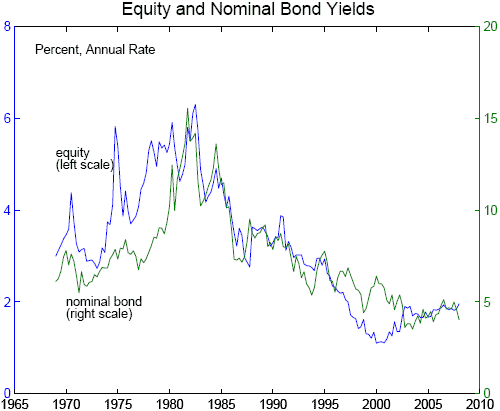Is the Fed Model an artifact of bad investor behavior (money illusion) or rational response? In the April 2008 draft of their paper entitled “Inflation and the Stock Market: Understanding the “Fed Model”, Geert Bekaert and Eric Engstrom carefully re-examine mechanisms that might explain why the Fed Model “works.” Using quarterly inputs for bond yield, S&P 500 index level and dividend yield, the economic forecast and a consumption-based measure of risk aversion spanning the fourth quarter of 1968 through 2007, they conclude that:
- The correlation between the stock dividend yield and the bond yield is 0.78 over the entire sample period. (See the chart below.)
- Most of the comovement of these yields derives from the fact that economic uncertainty (among professional forecasters) and (consumption-based) risk aversion are high when expected inflation is high. High uncertainty and risk aversion rationally drive the equity yield up, and high expected inflation rationally drives the bond yield up.
- Other countries in which high inflation tends to coincide with high economic uncertainty/risk aversion (stagflation), as experienced in the U.S., also have relatively high correlations between bond yields and equity yields.
- Money illusion plays no more than a small part in the relationship between stock and bond yields.
The following chart, taken from the paper, plots the equity yield (blue, left scale), and the bond yield (green, right scale) from the fourth quarter of 1968 through 2007. The equity yield is the aggregate dividend yield for the S&P 500, and the nominal bond yield is that of the 10-year constant-maturity Treasury note.

In summary, the high correlation between equity yield and bond yield derives rationally from the tendency for inflation to be elevated during recessions, such that both equity and bond premiums are relatively high during recessions.